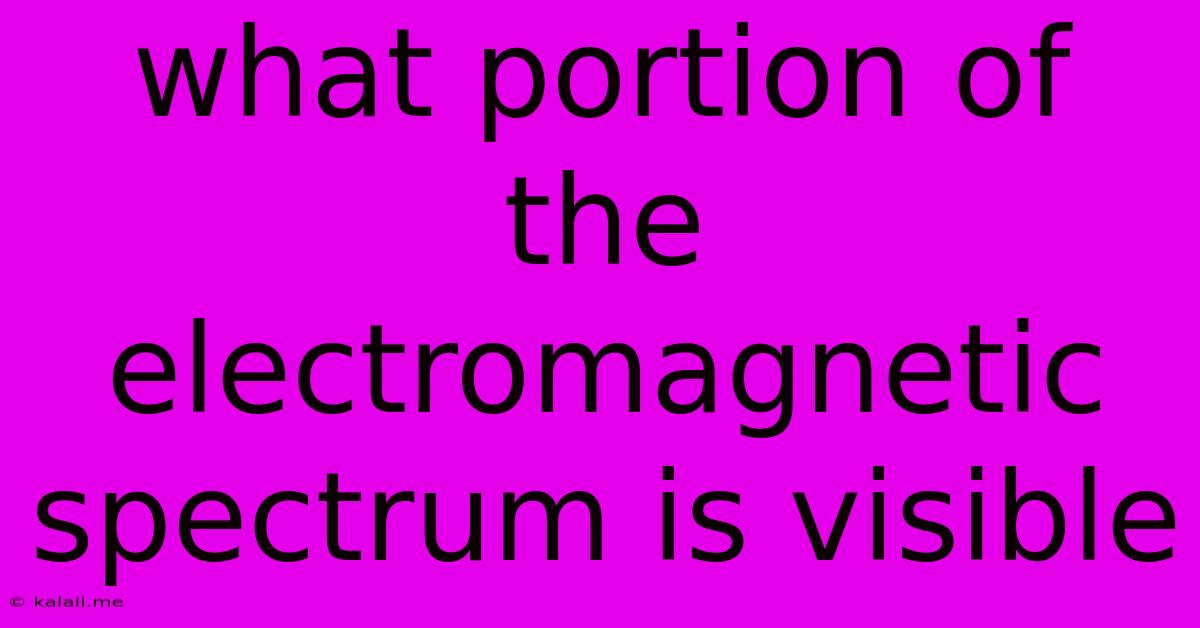What Portion Of The Electromagnetic Spectrum Is Visible
Kalali
Jun 15, 2025 · 3 min read

Table of Contents
What Portion of the Electromagnetic Spectrum is Visible?
The electromagnetic spectrum is vast, encompassing a wide range of wavelengths and frequencies of energy. Only a tiny sliver of this spectrum is visible to the human eye – a remarkable fact considering the universe's diverse energy emissions. This article will delve into the specifics of this visible light portion, exploring its characteristics and significance.
Understanding the Electromagnetic Spectrum
The electromagnetic spectrum arranges electromagnetic radiation – energy that travels in waves – according to its wavelength and frequency. These waves range from extremely long radio waves to incredibly short gamma rays. Between these extremes lie various forms of radiation, including microwaves, infrared radiation, visible light, ultraviolet radiation, X-rays, and gamma rays. All these forms of radiation share the same fundamental nature, differing only in their wavelength and frequency.
The Visible Light Spectrum: A Narrow Band of Color
Visible light represents a remarkably small portion of the entire electromagnetic spectrum. It occupies a range of wavelengths approximately between 400 and 700 nanometers (nm). This seemingly small window is precisely what our eyes have evolved to detect, allowing us to perceive the world around us in vibrant color.
Within this 300 nm range, we perceive a continuous spectrum of colors. The shortest wavelengths (around 400 nm) appear violet, while the longest wavelengths (around 700 nm) appear red. Between these extremes, we see blue, green, yellow, orange, and all the shades in between – a beautiful and continuous gradient of hues. This is the rainbow effect, a visible representation of the spectrum's gradual wavelength shift.
The Significance of Visible Light
The visible portion of the electromagnetic spectrum is crucial for several reasons:
-
Vision: This is the most obvious reason. Our eyes have specialized photoreceptor cells (rods and cones) that are sensitive to wavelengths in this range, enabling us to see.
-
Photosynthesis: Plants utilize visible light, especially red and blue wavelengths, for photosynthesis, the process by which they convert light energy into chemical energy. This is fundamental to most life on Earth.
-
Communication: Visible light is also used in various communication technologies, such as fiber optics, which use light pulses to transmit data at high speeds.
-
Color Perception: The diversity of colors within the visible spectrum contributes significantly to our aesthetic experience and our understanding of the world. Color helps us differentiate objects, understand their properties, and appreciate the beauty of nature.
Beyond the Visible: The Invisible Spectrum
While visible light plays a pivotal role, it's essential to remember the vastness of the electromagnetic spectrum beyond what we can see. Infrared radiation provides warmth, ultraviolet radiation contributes to vitamin D production (though excessive exposure can be harmful), X-rays are vital for medical imaging, and gamma rays, while dangerous, are used in various scientific applications. Understanding the full spectrum gives a more complete picture of the energy pervading our universe.
In conclusion, the visible portion of the electromagnetic spectrum is a relatively narrow band of wavelengths, ranging from approximately 400 to 700 nm. Despite its limited size, it underpins our visual perception, plays a key role in biological processes, and is used in various technologies. Recognizing its position within the broader electromagnetic spectrum provides a deeper appreciation of its significance and the energy that surrounds us.
Latest Posts
Latest Posts
-
Which Of The Following Is A Steroid Hormone
Jun 15, 2025
-
What Is The Measure Of Angle E
Jun 15, 2025
-
Lines Of Symmetry Of A Regular Hexagon
Jun 15, 2025
-
The Function Of The Dartos And Cremaster Muscles Is To
Jun 15, 2025
-
One Barrel Of Crude Oil In Litres
Jun 15, 2025
Related Post
Thank you for visiting our website which covers about What Portion Of The Electromagnetic Spectrum Is Visible . We hope the information provided has been useful to you. Feel free to contact us if you have any questions or need further assistance. See you next time and don't miss to bookmark.